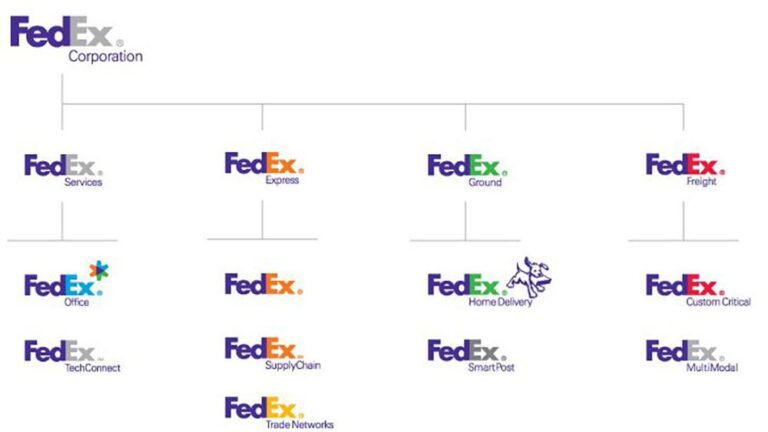In business, numerous brands often fall under the expansive umbrella of a larger corporation. This parent company uses various brand names to introduce a wide array of products and services, catering to diverse market segments. This intricate relationship among brands is commonly referred to as a brand portfolio, where the parent brand oversees a collection of sub-brands.
Visualize this arrangement as a family tree, where the main brand serves as the head of the family. In this analogy, the branches and offshoots represent distinct brands, each tailored to specific audiences and market niches. These brands can either be sub-brands directly associated with the parent or operate as independent entities in their own right.
Each brand within this portfolio operates independently, having the freedom to function differently from its parent company while still being an integral part of the parent brand’s overall strategy. The degree of alignment between the parent brand and its sub-brands can vary, with some brands being closely connected and others maintaining a more distinct identity.
To illustrate, consider the Armani brand portfolio, where Emporio Armani, Giorgio Armani, and Armani Exchange are all brand extensions, intricately woven within the broader Armani brand portfolio. On the other hand, brands like Always, Head & Shoulders, and Pampers stand independently as individual entities within Procter & Gamble’s extensive brand portfolio.
Understanding the concept of brand portfolios is crucial as it offers businesses strategic advantages. By managing a diverse range of brands, companies can effectively target specific market segments, enhance brand recognition, and capitalize on various consumer preferences. This approach allows businesses to maintain flexibility and adaptability in response to market demands while ensuring a cohesive overall brand identity.
Examining well-known examples of brand portfolios provides valuable insights into the complex and interconnected world of branding strategies. Through careful management and strategic alignment, businesses can leverage the power of brand portfolios to drive growth and success in the competitive marketplace.
Understanding Brand Portfolios
What is a Brand Portfolio?
A brand portfolio signifies a cluster of brands operating under a wider “brand umbrella” established by a corporation or conglomerate. A classic illustration of a brand portfolio is evident in The Coca-Cola Company, renowned for its flagship product, Coke. Yet, beyond Coke, this global entity manages a staggering array of over 200 brands. These encompass soft drinks, alcoholic beverages, juices, teas, and dairy products. Familiar household names like Sprite, Fanta, and Costa Coffee all find their place within the expansive Coca-Cola brand family.
Businesses craft, expand, and preserve brand portfolios with the objective of establishing a presence across diverse market segments and appealing to a wider spectrum of potential clientele. The rationale for brand portfolios permeates every industry since this strategic approach empowers companies to grow and augment their market influence.
When to Implement a Brand Portfolio Strategy
Contrary to common belief, the concept of a brand portfolio isn’t exclusive to colossal revenue-generating giants. Even smaller brands with an assortment of products can choose to distinctly brand each item. This approach fosters clarity and transparency, forming the basis for sustainable growth. Additionally, well-established brands eyeing entry into new markets or aiming to bolster their market share often opt to introduce new sub-brands. This move not only establishes an umbrella branding structure but also marks the inception of their brand portfolio.
The decision to employ a brand portfolio typically hinges on objectives related to diversification, expansion, and the pursuit of an amplified market presence. In essence, it’s a strategic maneuver that enables businesses, regardless of their size, to navigate market complexities, enhance consumer engagement, and fortify their foothold in the competitive landscape.
Understanding Brand Portfolio Roles
In the realm of brand portfolios, there are four primary roles that brands can play: flanker brands, cash cow brands, low-end entry-level brands, and high-end prestige brands.
Flanker Brands
A flanker brand is an innovative strategy employed by a company wherein a new brand is introduced within a product category where the company already has a well-established brand. The purpose of this new brand is to cater to the needs of potential customers that the original brand might not effectively address within that specific product category. The idea is to create distinct brands that resonate with diverse consumers across various market segments without encroaching on the territory of other brands within the same portfolio.
For instance, Diet Coke serves as a flanker brand to Coke, enabling the company to tap into the health-conscious market segment. Despite being competitors in the market (where a consumer might choose either Coke or Diet Coke), these brands collaborate effectively, complementing each other rather than competing for the same audience. By targeting different consumer preferences within a product category, the parent company aims to reinforce its market position and ward off competitors.
Cash Cow Brands
A brand achieves the status of a cash cow when it reaches a level of maturity and respect in the market. It becomes an established, respected brand that consistently generates substantial profits for the company, often representing the parent brand. These branded products have matured in their life cycle but continue to sell well, ensuring a steady cash flow for the company. Unlike introducing new products to replace them, the strategy with cash cow brands is to maintain the status quo and allow these brands to persist, generating consistent revenue. Consequently, they are rarely discontinued from the market, leveraging their established reputation and market presence.
Entry-Level Brands
Within the intricate tapestry of brand portfolios, entry-level brands occupy a pivotal space. These brands are the budget-friendly options nestled under the umbrella of the parent company. Offering products at lower price points, entry-level brands serve as gateways, enticing cost-conscious customers into the broader brand family. The allure of affordability often captures consumers’ attention, acting as a stepping stone into the parent brand’s diverse offerings.
For instance, consider Marriott’s offerings. If a customer opts for the most economical choice within Marriott’s range of accommodations and finds the service and brand experience satisfactory, they might be enticed to explore more luxurious options in the future. This phenomenon reflects the natural progression of a customer’s preferences and budget as they mature and their income grows over time.
High-End Prestige Brands
On the opposite end of the spectrum are high-end prestige brands, meticulously crafted to exude an aura of opulence and unparalleled quality. These brands epitomize luxury, aiming to deliver an exceptional, elite experience to their discerning clientele.
To illustrate, take the example of Toyota, a brand renowned for its affordability. Venturing into the luxury car market under the same brand name would prove challenging, given its established reputation. Thus, the creation of an independent luxury brand becomes imperative. By detaching from the affordable image associated with Toyota, this distinct luxury brand can establish its unique identity, one steeped in prestige and exclusivity.
In essence, the strategic positioning of entry-level brands and high-end prestige brands within a brand portfolio enables companies to cater to diverse consumer segments. These brands not only capture different market niches but also pave the way for brand evolution, ensuring sustained customer engagement and long-term brand loyalty.
Benefits of Brand Portfolios
Effective brand management hinges on establishing a profound connection with the audience through thoughtful messaging and experiences while maintaining the delicate balance of customer relationships. However, consumer preferences can evolve, potentially leading a single brand to face a shrinking market share despite having a loyal customer base. In such scenarios, brand strategists might find it challenging for their existing brand to venture into new market segments without jeopardizing their existing customer base. This is where the brand portfolio strategy steps in, offering a solution to increase a company’s market share by acquiring established brands or introducing new ones.
With adept brand portfolio management, the entire portfolio operates as a unified entity, sharing the core values and principles of the parent company. For example, consumers expect a consistently high standard from Unilever products and associate Microsoft brands with professionalism and innovation. This alignment within portfolios can manifest in different structures: the “Branded House” model, exemplified by brands like Virgin and FedEx, where brands exist within the same family and are clearly endorsed, or the “House of Brands” model, as seen with Unilever and Procter & Gamble, where brands operate with more independence within the portfolio.
This brand architecture, representing the relationships between brands, is pivotal. Clear associations within the portfolio enhance brand equity and reputation. For instance, when Nestle or Kellogg’s introduces a new food product, the credibility is boosted with their logos on the packaging. Virgin, as the parent brand, employs a “Branded House” structure, where each sub-brand is endorsed by Virgin, leveraging the existing reputation. This strategic advantage allows Virgin to launch sub-brands like Virgin Media, Virgin Mobile, and Virgin Atlantic, capitalizing on the trust established by the parent brand.
Case Study: Navigating Brand Challenges through Strategic Brand Portfolio Management
Consider a high-end luxury clothing company faced with a compelling dilemma. This esteemed flagship brand has established itself as a symbol of status, enabling it to command premium prices from an exclusive clientele. However, meticulous market research reveals a significant shift in customer preferences. A substantial portion of the target market now leans towards more budget-friendly clothing options. This poses a profound challenge for the flagship brand, whose identity is intricately woven around luxury and exclusivity.
The predicament arises from the fact that altering the pricing strategy for the flagship brand’s products might alienate its most loyal customers, who expect nothing short of opulence at a premium. To navigate this intricate situation, the company could opt for a strategic move: the creation of a new brand or the acquisition of an existing one to cater to the evolving market demands.
This new brand would focus solely on providing affordable clothing, accompanied by a branding strategy tailored to resonate with cost-conscious consumers. By adopting this approach, the flagship brand avoids the peril of conflicting messaging that could damage its image if it were to introduce more affordable products under its established name. This new brand, while distinct, would become an integral part of the flagship brand’s comprehensive brand portfolio.
A notable example of successful brand portfolio management is evident in Toyota’s foray into the luxury car market in 1989. Recognizing the challenge posed by its reputation as an affordable car brand, Toyota astutely introduced the luxury car brand Lexus as a sub-brand within its portfolio. Within a brand portfolio, each brand assumes specific roles, contributing significantly to the overarching brand strategy. Businesses often cultivate and sustain brands with distinct roles to complement each other effectively. This strategic synergy not only bolsters competitiveness but also facilitates market share growth within specific categories.
Real-World Examples Brand Portfolio
Brand portfolios are a common sight across various industries, showcasing a range of strategic approaches. Let’s delve into notable examples to understand their unique structures:
Unilever (House Of Brands)
Unilever, a global powerhouse, oversees a vast family of over 400 companies spanning home goods, food, and healthcare. What unites these diverse brands is a shared commitment to “do good” and promote “sustainable living commonplace.” Each brand operates independently, emphasizing its unique identity within the broader Unilever umbrella.
Nestle (Hybrid)
Nestle, the world’s largest food and beverage company, employs a hybrid brand architecture, blending aspects of a Branded House and a House of Brands. Some products feature endorsed brands closely aligned with Nestle, while others operate independently. This flexible approach allows Nestle to offer a diverse array of products, each with its distinct brand identity, catering to a wide market spectrum.
Pepsico (House Of Brands)
Pepsico, a notable competitor of the Coca-Cola Company, boasts an extensive brand portfolio, incorporating giants like Frito-Lay. In their House of Brands model, each brand functions independently, maintaining its unique market presence. This strategy allows Pepsico to dominate both the beverage and snack industries while giving each brand the autonomy to thrive.
Johnson & Johnson (House Of Brands)
Johnson & Johnson’s brand portfolio spans multiple sectors within healthcare. Intriguingly, their approach varies. Products like baby lotion share the J&J branding, following a ‘Branded House’ architecture. However, other items like mouthwash operate under distinct labels like Listerine. This semi-autonomous structure provides each brand with flexibility, enabling them to adapt their branding without rigid constraints, ensuring better alignment with diverse consumer needs.
Apple (Branded House)
Apple, a technology titan, adopts a Branded House model, where each product, including iPhone and Apple TV+, stands as an individual brand. Despite their autonomy, these products incorporate Apple’s branding and visual identity, leveraging the credibility of the master brand. This cohesive approach enables Apple to introduce new products seamlessly, benefiting from the established Apple brand’s reputation.
FedEx (Branded House)
FedEx utilizes a Branded House structure for its services, with distinct brands like FedEx Express, FedEx Freight, FedEx Ground, and FedEx Kinkos. Each service is tailor-made for specific shipping needs, be it local or international, routine or urgent. This approach ensures customers have designated, specialized services catering to their diverse shipping requirements.
In essence, these real-world examples highlight the strategic diversity within brand portfolios, demonstrating how companies adapt their approaches to best fit their unique market positions and consumer demands. Each strategy, whether a House of Brands or a Branded House, reflects a nuanced understanding of market dynamics, ensuring sustained brand success.
Procter & Gamble (House Of Brands)
Procter & Gamble, a consumer goods giant, operates under a House of Brands model. This approach allows them to manage an extensive range of products, from cleaning supplies (like Tide and Febreze) to personal care items (like Gillette and Pantene). Each product operates as an individual brand, enabling Procter & Gamble to cater to diverse consumer needs without diluting the brand value of its flagship products.
General Electric (House Of Brands)
General Electric (GE) employs a House of Brands strategy across various sectors, including aviation, healthcare, energy, and appliances. Under this approach, GE operates distinct brands like GE Aviation and GE Healthcare. This diversification enables GE to maintain a strong presence in different industries, with each brand having its unique identity while benefiting from the overarching reputation of the parent company.
The Coca-Cola Company (Branded House)
In contrast to its competitor Pepsico, The Coca-Cola Company follows a Branded House model. All its products, whether Coca-Cola, Sprite, or Fanta, prominently feature the Coca-Cola branding. This approach leverages the equity of the Coca-Cola brand across all products, emphasizing a consistent message and visual identity. Customers associate any product under the Coca-Cola umbrella with the same quality and taste, enhancing brand loyalty.
Marriott International (House Of Brands)
Marriott International manages a diverse range of hotel brands, such as Marriott Hotels, Sheraton, and The Ritz-Carlton. Each brand operates independently under the Marriott umbrella. This House of Brands structure allows Marriott to target various market segments, from budget-conscious travelers to luxury-seeking guests, ensuring each brand caters to specific customer preferences without overlap.
Amazon (Branded House)
Amazon, a global e-commerce giant, embodies a Branded House strategy. Despite its vast array of products and services, from electronics (Amazon Echo) to entertainment (Amazon Prime Video), all services bear the Amazon branding. This consistent branding fosters trust and recognition, encouraging customers to explore new services under the Amazon umbrella, knowing they are backed by the company’s reputation for convenience and reliability.






![What is business strategy [Levels, Components, Examples]](https://naumandigital.com/wp-content/uploads/2023/02/2-600x400.jpg)

![How to Create a Brand Strategy [Comprehensive Guide]](https://naumandigital.com/wp-content/uploads/2023/10/brand-strategy-1-600x400.jpeg)
